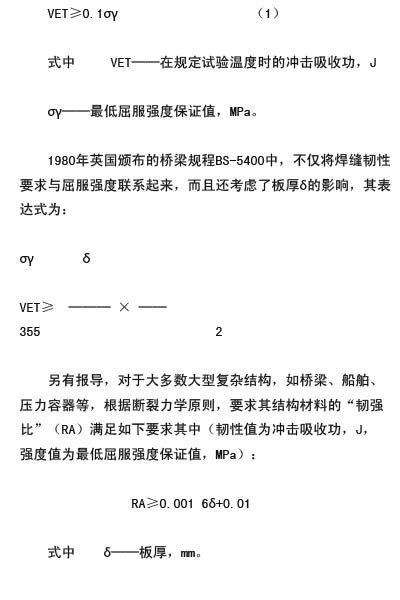2 Weldness index problem 2.1 Weld joint strength matching requirements for weld toughness Many failures of welded structures are typical brittle fractures that occur under low stress, and apparently no significant plastic deformation occurs before the fracture. The brittle fracture accidents in engineering always start from the existence of macroscopic defects or cracks as “sourcesâ€. Under the condition of far lower than the yield stress, it gradually expands due to fatigue or stress corrosion, and finally leads to sudden low. Stress fracture. As long as there is a source of cracks, the crack propagation always proceeds along the site of the worst toughness. From this point of view, it is always desirable to have a sufficient toughness reserve for the weakest part of the welded joint. Professor Chen Bojun and others have studied the strength and toughness of high-strength steel welds. It is concluded that the welded joints used in the strong or close-to-strong matching are the easiest to obtain the most excellent brittle fracture resistance. This is because the welding consumables used in the strong matching do not need to increase their toughness to be superior to the toughness required for low or super strong matching. If the fracture with low strength matching or super matching is to achieve the same strong matching fracture resistance, the toughness level of the welding material should be further improved. When the strength of the welding material is lowered, the toughness is easily improved; and when the strength of the welding material is increased, it is quite difficult to greatly increase the toughness. It can be seen that the low-strength matching is easier to improve the brittle fracture resistance of the joint than the super-strong matching. Therefore, in terms of anti-brittle fracture, super-strong matching is not necessarily beneficial. Under certain conditions, low-strength matching is feasible. For low-strength steel, both the base metal and the weld have a high toughness reserve. Therefore, when the welding material is selected according to the principle of equal strength, the strength requirement can be ensured without impairing the weld toughness. However, for high-strength steels, especially ultra-high-strength steels, the toughness of the welding materials used for matching is not high. If the welds and the base metal are still required, the toughness level of the welds may be reduced to the safety limit. Below, there may be brittle fracture due to insufficient toughness. At this time, it is more advantageous to appropriately reduce the weld strength and increase the toughness thereof. There have been accidents in this respect. When a tank with a capacity of 10,000 tons is brittle, the strength and elongation of the tank are qualified. The brittle fracture is mainly caused by insufficient toughness. At present, the most widely used toughness judgment is the Charpy sample impact absorption work of the V-shaped notch, which is based on the analysis experience of the American hull damage accident in the early 1940s [5]. At that time, the hulls were all made of low-carbon boiling steel. When tested at the accident temperature, the impact absorption work of the unbroken part of the hull steel averaged 21 J (15 ft-1 h). Therefore, it is considered that this value can be used as a judgment. The critical temperature was determined, the so-called VTr15 judgment, and later developed to have an average impact absorption of not less than 27 J (20 fr-1b), and one sample was allowed to fall below this value, but not less than 21 J. In 1954, there was another accident in which the oil tanker broke into two halves. The hull steel was fine-grained steel or low-alloy steel. According to the investigation by Lloyd's Register of Shipping, the V-shaped notch impact absorption of this type of steel is low. At 47 J (35 fr-1b), brittle fracture is prone to occur, so the 47 J shock absorption work is proposed as the minimum guaranteed value. It can be seen that under the same conditions of use and toughness, high strength steel is more susceptible to fracture than low strength steel. For safety reasons, the requirements for the impact absorption of steel should be appropriately increased with the increase of its strength. In 1978, the Norwegian Classification Society gave the relationship between the required value of the impact absorption work and the lowest value of the yield strength in the classification specification of the oil production platform. It is written as a mathematical formula: Yield strength Re/MPa Tensile strength Rm/MPa Elongation A() Impact temperature T/°C Impact absorption work AkV/J The values ​​in this table are consistent with the mathematical formula VET=0.1σγ, which is also used by national classification societies. The author believes that the scope of application of VET=0.1σγ is not unlimited, but has certain limitations. The strength and toughness matching index of 69 J at 690 MPa and -60 ° C listed in the table is already the upper limit range, and further improvement of the dual requirements of strength and impact work will be difficult to achieve. This is determined by the properties of the metal material itself, and the strength and toughness are mutually constrained. Previous Next Copper Braid,1.5M Length Repairing Soldering,Desoldering Wire Hand Soldering,Desoldering Wire Repairing Soldering NINGBO XIHAN TIN SOLDER CO.,LTD. , https://www.soldertop.com
2.2 Related indicators of weld toughness 
In recent years, China Classification Society (CCS) has made reference to the specifications of foreign classification societies (LR, NV, ABS, NK) for the strength and toughness of deposited metal for high-strength steel electrodes, automatic welding and semi-automatic Welding Wire. The regulations are shown in Table 1.
Table 1 Mechanical properties of deposited metal for high strength steel welding consumables
≥400 510~690 ≥22 0~-60 ≥47
≥460 570~720 ≥20 -20~-60 ≥47
≥500 610~770 ≥18 -20~-60 ≥50
≥550 660~830 ≥18 -20~-60 ≥55
≥620 720~880 ≥18 -20~-60 ≥62
≥690 770~940 ≥18 -20~-60 ≥69